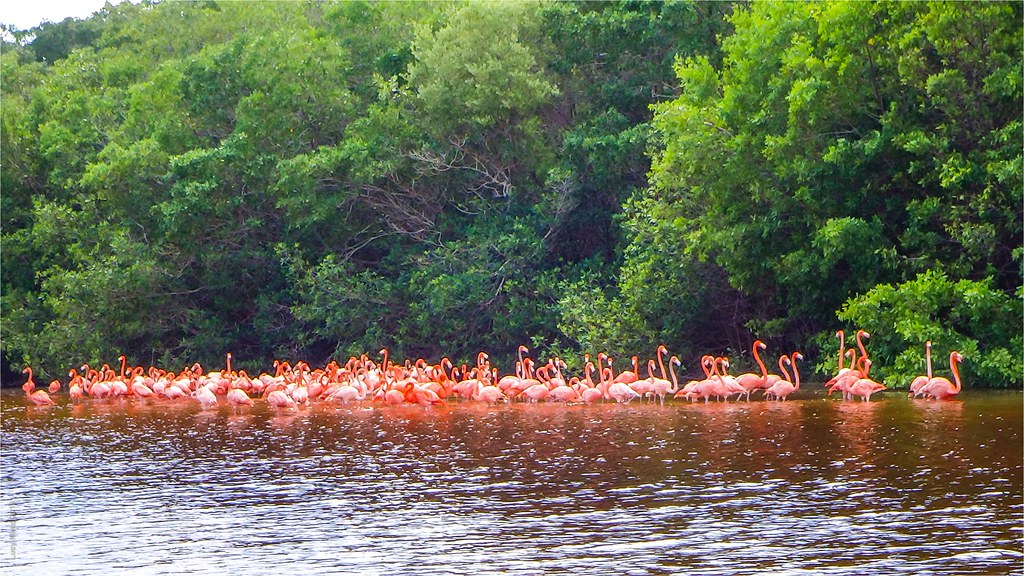Yucatán, México — Con sus impresionantes paisajes y rica biodiversidad, Yucatán se ha convertido en un destino privilegiado para los fotógrafos de naturaleza que buscan capturar la esencia del mundo natural. Desde sus cenotes místicos hasta sus reservas de biosfera, el estado ofrece una variedad de escenarios ideales para la fotografía.
Uno de los puntos más destacados es la Reserva de la Biosfera Ría Celestún, famosa por sus flamencos rosados. Entre noviembre y marzo, este lugar se convierte en un refugio para estas aves migratorias, ofreciendo oportunidades inigualables para los fotógrafos. Las tranquilas aguas de la ría, rodeadas de manglares, crean un entorno perfecto para capturar la belleza de la fauna aviar.
Otro destino imperdible es el Cenote Ik Kil, ubicado cerca de Chichén Itzá. Este cenote, conocido por su impresionante abertura rodeada de vegetación, se ha vuelto un favorito entre los fotógrafos. La luz que se filtra en el interior del cenote proporciona una atmósfera mágica, ideal para la captura de imágenes etéreas.
El Parque Nacional de Tulum no solo ofrece ruinas mayas frente al mar, sino también una rica biodiversidad. Con sus playas de arena blanca y acantilados dramáticos, el parque es perfecto para quienes buscan capturar tanto la historia como la belleza natural. Los amaneceres y atardeceres en este lugar son especialmente espectaculares, brindando colores vibrantes que se reflejan en el océano.
La Reserva de la Biosfera de Calakmul es otra joya en el corazón de la selva yucateca. Considerada una de las áreas protegidas más grandes de México, alberga una gran variedad de especies, incluyendo jaguares y monos aulladores. Este sitio, que combina la riqueza natural con antiguas ruinas mayas, ofrece un escenario único para la fotografía.
Finalmente, la Reserva de la Biosfera de Sian Ka’an, Patrimonio de la Humanidad, es un tesoro de biodiversidad. Sus manglares y arrecifes de coral son el hogar de delfines, tortugas marinas y una multitud de aves. Los recorridos en kayak por sus canales permiten a los fotógrafos acercarse a la flora y fauna en su hábitat natural, ofreciendo imágenes impresionantes.
Para aquellos interesados en capturar la belleza natural de Yucatán, los expertos recomiendan fotografiar durante las horas doradas del amanecer y el atardecer, así como llevar un lente zoom para retratar la fauna sin perturbarla. Además, es fundamental respetar el entorno y seguir las normativas de cada reserva para proteger estos valiosos ecosistemas.
Yucatán, con su fusión de cultura e naturaleza, se perfila como un destino esencial para la fotografía de naturaleza, prometiendo momentos inolvidables y oportunidades únicas para quienes buscan inmortalizar la belleza de este rincón de México.
INGLES
Yucatán, Mexico — With its stunning landscapes and rich biodiversity, Yucatán has become a prime destination for nature photographers seeking to capture the essence of the natural world. From its mystical cenotes to its biosphere reserves, the state offers a variety of ideal settings for photography.
One of the highlights is the Ría Celestún Biosphere Reserve, famous for its pink flamingos. Between November and March, this area transforms into a refuge for these migratory birds, providing unparalleled opportunities for photographers. The tranquil waters of the ría, surrounded by mangroves, create a perfect environment to capture the beauty of avian wildlife.
Another must-visit destination is Cenote Ik Kil, located near Chichén Itzá. This cenote, known for its impressive opening surrounded by lush vegetation, has become a favorite among photographers. The light filtering into the cenote creates a magical atmosphere, ideal for capturing ethereal images.
The Tulum National Park not only features Mayan ruins by the sea but also boasts rich biodiversity. With its white sandy beaches and dramatic cliffs, the park is perfect for those looking to capture both history and natural beauty. Sunrises and sunsets in this location are particularly spectacular, offering vibrant colors that reflect in the ocean.
The Calakmul Biosphere Reserve is another gem in the heart of the Yucatán jungle. Considered one of the largest protected areas in Mexico, it is home to a wide variety of species, including jaguars and howler monkeys. This site, which combines natural richness with ancient Mayan ruins, offers a unique backdrop for photography.
Finally, the Sian Ka’an Biosphere Reserve, a UNESCO World Heritage site, is a treasure trove of biodiversity. Its mangroves and coral reefs are home to dolphins, sea turtles, and a multitude of birds. Kayaking through its channels allows photographers to get close to flora and fauna in their natural habitat, offering stunning images.
For those interested in capturing Yucatán’s natural beauty, experts recommend shooting during the golden hours of dawn and dusk, as well as using a zoom lens to photograph wildlife without disturbing it. Additionally, it is crucial to respect the environment and follow the regulations of each reserve to protect these valuable ecosystems.
Yucatán, with its blend of culture and nature, stands out as an essential destination for nature photography, promising unforgettable moments and unique opportunities for those looking to immortalize the beauty of this corner of Mexico.

